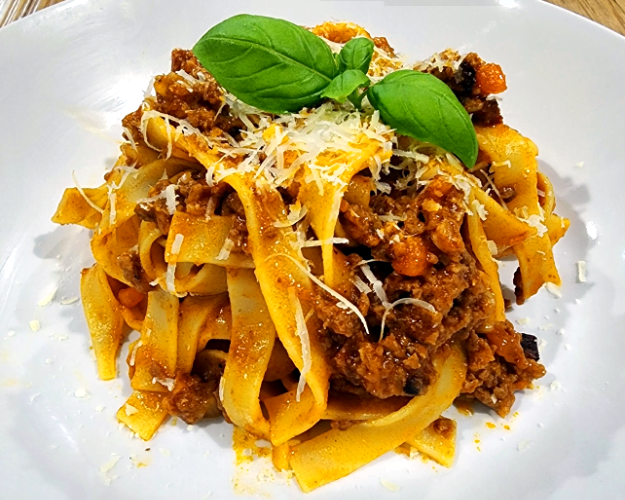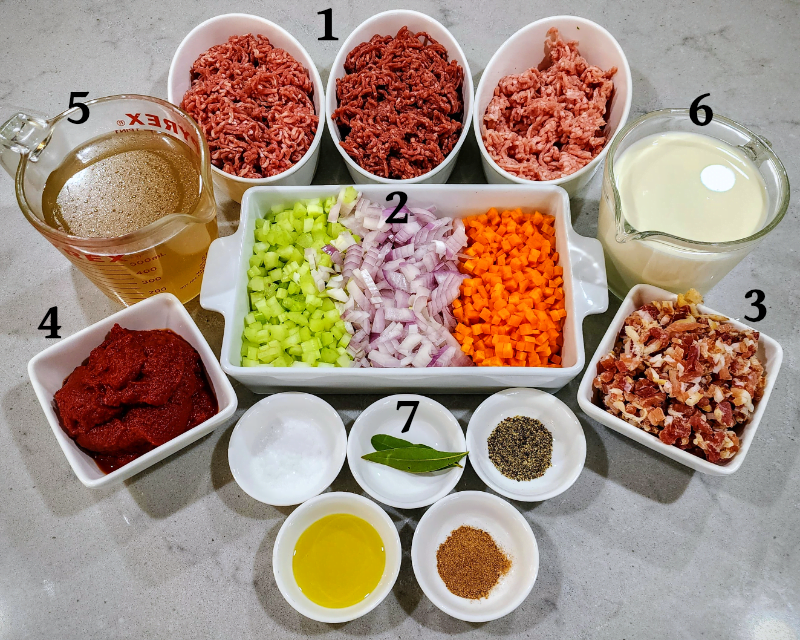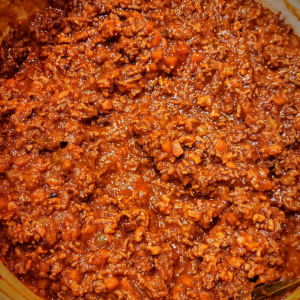Ragù alla Bolognese

Spaghetti Bolognese is a classic dish all around the world. Especially us Aussies and Brits with our “Spag Bol”. We all grew up eating it. Near every Pizzeria and Italian Restaurant we went to served it, and our mums made it near every week. But, there’s one place in the world where you’ll never find Spaghetti Bolognese… Italy!
That’s right. Spaghetti Bolognese is not, and has never been, a thing in Italy. In fact, most of what we’ve been cooking, or is served, as Bolognese Sauce outside of Italy is nothing like proper Ragù alla Bolognese at all!
What we get most of the time is more likely just cooked beef mince swimming in a tomato sauce. That’s the exact opposite of what a good Ragù alla Bolognese should be.
Now, don’t get me wrong. I think ‘Spag Bol’ has long since become a dish all its own. There’s nothing wrong with cooking up a big pot of Aussie Bolognese sauce full of tinned tomatoes, garlic and half a bottle of Masterfood’s Italian Herb Seasoning. Piling all that on top of spaghetti (all covered with cheese) and mopping up the sauce with garlic bread is an Australian institution!
But, it is time we separated the Italian-inspired dish we created from the authentic dish named after the Bologna region Italy where it was invented. So here, as traditional as I can make it with but a couple of slight variations, is my recipe for Ragù alla Bolognese.
What is Ragù alla Bolognese?
Italian Ragù alla Bolognese is essentially a slow cooked meat-based sauce. Its preparation involves several cooking techniques including sweating, sautéing and braising. Ingredients include a characteristic soffritto of onion, celery and carrot, various types of minced or finely chopped meat, often alongside small amounts of fatty pork. White wine, milk, and a small amount of tomato paste or tomatoes. The dish is then gently simmered at length to produce a thick sauce.
One thing you’ll notice in the above description is that tomatoes come last, and only ‘a small amount‘ is mentioned. Bolognese is not a tomato sauce. It is a meat sauce. And in Italian cooking that sauce generally only has two uses:
- to dress tagliatelle pasta for the dish Tagliatelle al Ragù alla Bolognese.
- as a filling in the traditional Lasagne alla Bolognese.
There’s actually an official recipe. Registered with the Academia Italiana Della Cucina (Italian Academy of Cuisine) by the city of Bologna where Ragù alla Bolognese originated in the 18th Century. It’s fairly strict in what you can and can’t do in order to call your recipe ‘authentic’.
Here’s the officially registered recipe if you’d like to have a read (and I recommend you do) but you’ll have to ask Google Translate for a hand if you can’t read Italian: https://www.accademiaitalianadellacucina.it/it/ricette/ricetta/ragù-classico-bolognese
I’ve tried to keep my recipe below as authentic as possible, but I do break the rules in two tiny places.
First, on the NOT ALLOWED list is this: “Garlic, rosemary, parsley, other herbs or spices“.
Now, I agree that garlic definitely has no place in a true Bolognese and rosemary is too strong for the subtly complex flavours you want to develop with a slow-cook. Parsley, I see no harm in a little sprinkle on top at the end for garnish for serving, but I don’t do that either. The only herb I add is a couple of Fresh Bay Leaves. This is a herb that was once included in many recipes recorded in Bologna but is, for some reason, left out the official recipe. I include them because I feel they give a wonderfully savoury and slightly fragrant lift to the meat and tomatoes. But, they’re not essential, and if you can’t get Fresh Bay Leaves I probably wouldn’t even bother.
Second, also on the NOT ALLOWED list is this: “Veal mince”.
Again, this was once quite common and even the very first recorded recipe included Veal Mince as it’s only mince/ground-meat ingredient. I don’t know where or when this changed, but I use veal mince in my mix. 1 part Lean Beef Mince, 1 part Veal Mince, and 1/2 a part Pork Mince. I’ve found this ratio give the final ragù the perfect balance of meatiness from the beef, fattiness from the pork, and silkiness from the veal. If you don’t want to go to that trouble, that okay, just read the notes in the Ingredients list below for options.
Apart from these two ‘Rule Breakers’, I strongly encourage you to avoid the use of herbs (definitely no garlic, rosemary, thyme, or oregano) in order to get the best out of your Bolognese.
What to do with your Ragù
The first and most simple thing you should do with your Ragù is cook up some pasta! Preferably Tagliatelle – home-made if you can, because that is definitely best, or fresh from an Italian deli. But, dried Tagliatelle from your local supermarket will work just as well. Spaghetti is also a non-traditional option, and the sauce won’t stick to it as well, but if you’re a fan of the old ‘Spag Bol’ then you’ll never have tasted one quite as good as this.
The other option that works perfectly is Lasagne alla Bolognese! Thin pasta sheets layered with rich Ragù and creamy Besciamella (Italian Béchamel sauce), topped with a bit of mozzarella cheese and baked until golden brown on top. It is sooo delicious! I’ll try and do proper Lasagne post later — including details for making your own pasta — but until then check out this authentic Besciamella recipe: https://www.recipesfromitaly.com/bechamel-sauce-basic-white-sauce/
The Ingredients

1. Mince – I’m using beef mince, but you could easily substitute it for lamb mince (shepherd’s pie anyone?), kangaroo mince, pork mince, or a 50/50 beef and pork mince blend. I’m guessing you could even use one of those plant-based minces, but I’ve never tried.
2. Soffritto– a traditional Italian base of finely diced onion, celery and carrot. These ingredients add sweetness and flavour and aren’t optional.
3. Pancetta – yes, bacon is optional. But really, unless it’s a because of a dietary or religious requirement, why would you? Bacon adds heaps of flavour to the dish. Bacon makes everything better.
4. Tomato paste – Tomato paste is there to give the dish a lot of its unique savoury appeal. I find its a much better option than using tinned tomatoes as the flavour is more concentrated.
5. Stock – Here I’m using Beef Stock for that full savoury umami, but the recipe works just as well with Chicken or Vegetable stock. Remember to use less stock if you’re not adding pasta.
6. Milk– Use full cream milk, and don’t be put off by using it. It is an essential ingredient and will give the sauce a wonderful silky consistency.
7. Seasonings – Salt, pepper, bay leaf, olive oil, and the tiniest amount of nutmeg are all you need to bring out the true flavours of the ragù.
Notes
NOT SHOWN: There is one thing, not shown in the photo (but included in the recipe below), that is 100% ESSENTIAL!
That is Dry White Wine. Use it to deglaze the pan after browning the mince. It adds a wonderful sweetness to the dish. I use Pinot Grigio, but you could also use Pinot Gris, Sauvignon Blanc or an unoaked Chardonnay. It’s probably not in the photo because I was drinking it at the time!
The Recipe

Ragù alla Bolognese
Ingredients
- 1 tbsp Olive Oil
- 300 gm Lean Beef Mince
- 300 gm Veal Mince
- 150 gm Pork Mince
- 150 gm Pancetta finely chopped
- 1 medium Brown Onion finely diced
- 1 stick Celery finely diced
- 1 medium Carrot finely diced
- 1 cup Dry White Wine
- 300 gm Tomato Paste
- 2 Bay leaves fresh
- 1 tsp Salt
- 1 tsp Black Pepper
- 1 tsp Nutmeg ground
- 1 litre Chicken stock
- 2 cups Milk
Instructions
- Add olive oil and pancetta to a heavy based pan over medium heat and cook, stirring, for 2 minutes.1 tbsp Olive Oil, 150 gm Pancetta
- Add finely diced onion, celery and carrot. Stir to incorporate and 'sweat' the soffritto for 5 minutes. You want the onion to turn transparent, and not to brown, so turn the heat down if you need to.1 medium Brown Onion, 1 stick Celery, 1 medium Carrot
- Turn the heat up to high and add Beef Mince, Veal Mince, and Pork Mince. Break up the mince with a wooden spoon so there are no large chunks and stir it into the other ingredients. Cook for approximately 10 minutes until all the liquid has evaporated.300 gm Lean Beef Mince, 300 gm Veal Mince, 150 gm Pork Mince
- Deglaze the pan with the White Wine. Use a wooden spoon to scrape up any of the ingredients that may have stuck to the bottom of the pan. Add the tomato paste and stir through. Cook for another 2 minutes to remove the raw taste from the tomato paste.1 cup Dry White Wine, 300 gm Tomato Paste
- Add the Bay Leaves, Salt, Black Pepper and Nutmeg and stir through.2 Bay leaves, 1 tsp Salt, 1 tsp Black Pepper, 1 tsp Nutmeg
- Add the Chicken Stock. Stir through and bring to a boil. When boiling, turn down the heat to low and partly cover the pot with a lid (leave a gap for the water to evaporate) and simmer for 1 hour. Stir every 15 to 20 minutes to avoid the ragù sticking to the bottom of the pan.1 litre Chicken stock
- After 1 hour, add the milk and stir through. Recover and continue on a very low simmer for a further 2 hours. Stir every 15 to 20 minutes to avoid the ragù sticking to the bottom of the pan. If the Ragù becomes too dry, add a little water.2 cups Milk